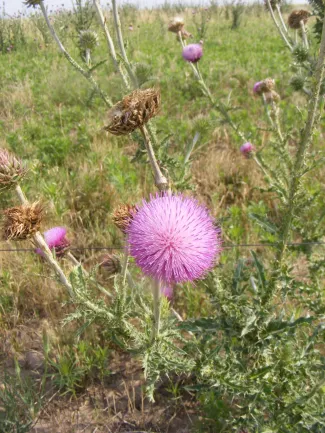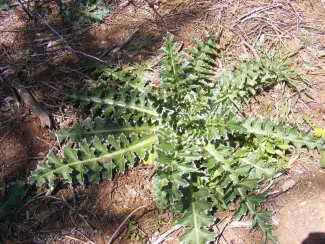Native to western Europe, the musk thistle was first noted in Oklahoma around 1960. Today, the plant is one of three thistles designated as noxious weeds in the state. Thankfully, the other two plants – scotch thistle and Canada thistle – are not nearly as common or as widespread. But Oklahomans aren’t as fortunate when it comes to the musk thistle.

Showy pink to purple flowers and spiny leaves are characteristics of the noxious musk thistle. (Kyle Johnson/ODWC)
Maintaining grasslands and rangelands in good to excellent condition can help prevent the establishment of musk thistle. However, even sound land management is not a 100 percent cure against these opportunistic weeds. Sometimes a small area of soil disturbance is all that is needed for one plant to grab hold and take off. At that point, monitoring and control will be required to reduce its spread.
Preventing plants from reaching the seed-developing stage is key for managing the spread of this thistle. Although some plant-eating insects (primarily weevils) can help with this endeavor, a combination of mechanical and chemical treatments is usually required.
The best proven control method is chemically treating musk thistle during its young rosette stage. A spring herbicide application is preferred, but a fall application is an option for seeds which germinate during the fall. The key is to monitor for fall- and spring-developing seedlings and treat the rosette of leaves during this young stage. Many herbicide options are available (Milestone, Tordon, 2,4-D, MCPA, Roundup), but control is best when the soil has adequate moisture and the air temperature is above 60 degrees. Spot spraying individual plants or groups of plants is recommended to avoid killing desirable native plants, especially perennial grasses.
Landowners missing the opportunity to chemically treat musk thistle during the rosette stage do have additional control options. Plants in the bolting stage, when the upright stem is produced, can still be sprayed with herbicides but may still produce mature seeds. Mechanically severing the root with a shovel or hoe between two and four inches below the soil surface will kill the plant and prevent re-sprouting. Mowing the plants as close to the ground as possible just before flowering can also be effective, though late season blooms can still occur if lower leaves and stems remain intact after mowing. For smaller infestations, clipping and removing flower heads can also help prevent seed production.
Although the purple-colored flowers of musk thistle can be somewhat attractive, the drawbacks of these nonnative plants are many, including their ability to outcompete native plants for space and reduce forage production. Maintaining healthy plant communities, keeping a watchful eye, and being ready to take action against the musk thistle are proactive measures to help prevent the spread of this weed across the landscape and improve wildlife habitat.

Musk thistle is best controlled with herbicide treatment of young rosettes. Severing the root and mowing are other control options. (Kyle Johnson/ODWC)